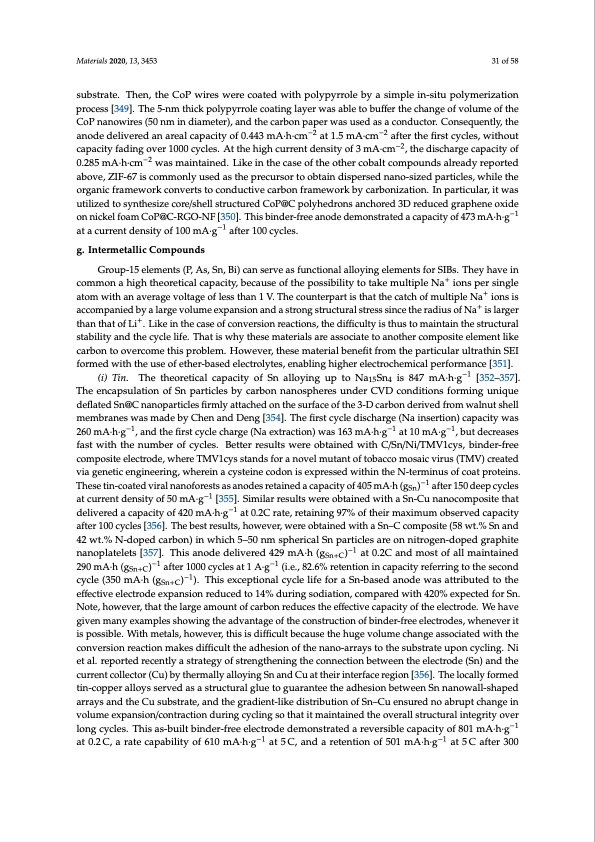
PDF Publication Title:
Text from PDF Page: 031
Materials 2020, 13, 3453 31 of 58 substrate. Then, the CoP wires were coated with polypyrrole by a simple in-situ polymerization process [349]. The 5-nm thick polypyrrole coating layer was able to buffer the change of volume of the CoP nanowires (50 nm in diameter), and the carbon paper was used as a conductor. Consequently, the anode delivered an areal capacity of 0.443 mA·h·cm−2 at 1.5 mA·cm−2 after the first cycles, without capacity fading over 1000 cycles. At the high current density of 3 mA·cm−2, the discharge capacity of 0.285 mA·h·cm−2 was maintained. Like in the case of the other cobalt compounds already reported above, ZIF-67 is commonly used as the precursor to obtain dispersed nano-sized particles, while the organic framework converts to conductive carbon framework by carbonization. In particular, it was utilized to synthesize core/shell structured CoP@C polyhedrons anchored 3D reduced graphene oxide on nickel foam CoP@C-RGO-NF [350]. This binder-free anode demonstrated a capacity of 473 mA·h·g−1 at a current density of 100 mA·g−1 after 100 cycles. g. Intermetallic Compounds Group-15 elements (P, As, Sn, Bi) can serve as functional alloying elements for SIBs. They have in common a high theoretical capacity, because of the possibility to take multiple Na+ ions per single atom with an average voltage of less than 1 V. The counterpart is that the catch of multiple Na+ ions is accompanied by a large volume expansion and a strong structural stress since the radius of Na+ is larger than that of Li+. Like in the case of conversion reactions, the difficulty is thus to maintain the structural stability and the cycle life. That is why these materials are associate to another composite element like carbon to overcome this problem. However, these material benefit from the particular ultrathin SEI formed with the use of ether-based electrolytes, enabling higher electrochemical performance [351]. (i) Tin. The theoretical capacity of Sn alloying up to Na15Sn4 is 847 mA·h·g−1 [352–357]. The encapsulation of Sn particles by carbon nanospheres under CVD conditions forming unique deflated Sn@C nanoparticles firmly attached on the surface of the 3-D carbon derived from walnut shell membranes was made by Chen and Deng [354]. The first cycle discharge (Na insertion) capacity was 260 mA·h·g−1, and the first cycle charge (Na extraction) was 163 mA·h·g−1 at 10 mA·g−1, but decreases fast with the number of cycles. Better results were obtained with C/Sn/Ni/TMV1cys, binder-free composite electrode, where TMV1cys stands for a novel mutant of tobacco mosaic virus (TMV) created via genetic engineering, wherein a cysteine codon is expressed within the N-terminus of coat proteins. These tin-coated viral nanoforests as anodes retained a capacity of 405 mA·h (gSn)−1 after 150 deep cycles at current density of 50 mA·g−1 [355]. Similar results were obtained with a Sn-Cu nanocomposite that delivered a capacity of 420 mA·h·g−1 at 0.2C rate, retaining 97% of their maximum observed capacity after 100 cycles [356]. The best results, however, were obtained with a Sn–C composite (58 wt.% Sn and 42 wt.% N-doped carbon) in which 5–50 nm spherical Sn particles are on nitrogen-doped graphite nanoplatelets [357]. This anode delivered 429 mA·h (gSn+C)−1 at 0.2C and most of all maintained 290 mA·h (gSn+C)−1 after 1000 cycles at 1 A·g−1 (i.e., 82.6% retention in capacity referring to the second cycle (350 mA·h (gSn+C)−1). This exceptional cycle life for a Sn-based anode was attributed to the effective electrode expansion reduced to 14% during sodiation, compared with 420% expected for Sn. Note, however, that the large amount of carbon reduces the effective capacity of the electrode. We have given many examples showing the advantage of the construction of binder-free electrodes, whenever it is possible. With metals, however, this is difficult because the huge volume change associated with the conversion reaction makes difficult the adhesion of the nano-arrays to the substrate upon cycling. Ni et al. reported recently a strategy of strengthening the connection between the electrode (Sn) and the current collector (Cu) by thermally alloying Sn and Cu at their interface region [356]. The locally formed tin-copper alloys served as a structural glue to guarantee the adhesion between Sn nanowall-shaped arrays and the Cu substrate, and the gradient-like distribution of Sn–Cu ensured no abrupt change in volume expansion/contraction during cycling so that it maintained the overall structural integrity over long cycles. This as-built binder-free electrode demonstrated a reversible capacity of 801 mA·h·g−1 at 0.2 C, a rate capability of 610 mA·h·g−1 at 5 C, and a retention of 501 mA·h·g−1 at 5 C after 300PDF Image | Electrode Materials for Sodium-Ion Batteries

PDF Search Title:
Electrode Materials for Sodium-Ion BatteriesOriginal File Name Searched:
materials-13-03453-v2.pdfDIY PDF Search: Google It | Yahoo | Bing
Salgenx Redox Flow Battery Technology: Salt water flow battery technology with low cost and great energy density that can be used for power storage and thermal storage. Let us de-risk your production using our license. Our aqueous flow battery is less cost than Tesla Megapack and available faster. Redox flow battery. No membrane needed like with Vanadium, or Bromine. Salgenx flow battery
| CONTACT TEL: 608-238-6001 Email: greg@salgenx.com | RSS | AMP |